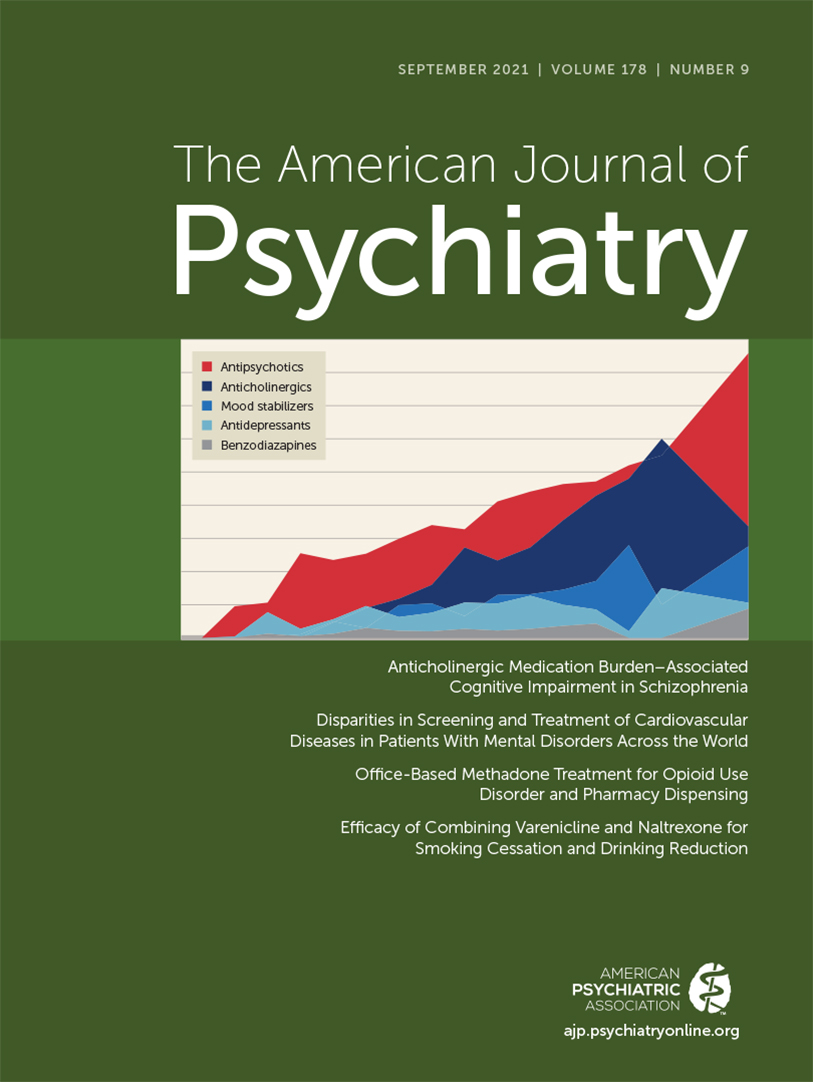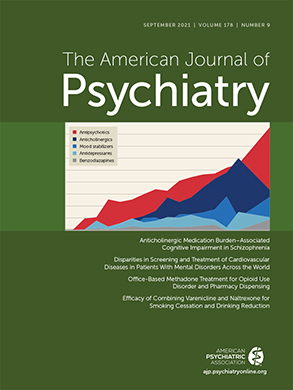Cigarette smoking and heavy alcohol drinking frequently co-occur. Nearly 20% of smokers drink heavily, compared with 6.5% of nonsmokers, and heavy drinkers are 2–3 times more likely to smoke than non-heavy drinkers (
1). Alcohol use is a well-documented smoking lapse/relapse precipitant and may account for heavy-drinking smokers’ lower smoking quit rates with currently approved treatments compared with non-heavy-drinking smokers (
2). Likewise, continued smoking decreases the odds of successful drinking reduction (
3). Co-occurring tobacco and alcohol use is associated with worse morbidity and premature mortality than use of either substance alone (
4). Yet, despite these risks, there are no approved treatments or best practices outlined for heavy-drinking smokers. Moreover, these patients typically receive either no treatment or separate substance use disorder treatment without integration.
There is an urgent need to develop efficacious treatment approaches for combined smoking and heavy drinking. Integrated interventions and novel pharmacotherapy combinations that target both smoking and drinking behaviors may hold promise (
5,
6). Among the top medication combination possibilities are varenicline and naltrexone, which target the neuronal nicotinic acetylcholine and opioid receptor systems, respectively, involved in nicotine and alcohol reinforcement (
5). Varenicline is approved for smoking cessation, and naltrexone is approved for the treatment of alcohol use disorder (AUD). Preliminary human laboratory research provides support for their potential combined efficacy in heavy-drinking smokers to reduce smoking craving and ad libitum smoking and drinking (
7).
In this issue, Ray et al. (
8) report on a randomized double-blind superiority trial of varenicline combined with either naltrexone or placebo in 165 heavy-drinking smokers seeking treatment for tobacco cessation and drinking reduction. After appropriate titration intervals, both medications were delivered at their standard approved dosages—2 mg/day (1 mg b.i.d.) of varenicline and 50 mg/day of naltrexone—for 12 weeks. At enrollment, participants received a brief (<1 hour) on-site counseling session to set a smoking quit date and a drinking goal. Thereafter, participants had monthly study visits during treatment and again 16 and 26 weeks after medication discontinuation. Among all participants, drinks consumed per drinking day was reduced during treatment, and the combined treatment of varenicline and naltrexone was associated with a further reduction in drinking rates by approximately one drink per occasion, although this fell short of statistical significance. However, the combined treatment did not improve tobacco cessation rates, and in fact resulted in significantly worse quit rates at week 26 (26.5%) relative to varenicline alone (45.1% with varenicline and placebo).
The Ray et al. study has several strengths, including a racially diverse sample (46% Black participants), assessment of both alcohol and smoking outcomes during treatment and follow-up, and a good retention rate of 72% at the primary week-26 endpoint. Combined medication approaches, such as the one used in this study, can be challenging because of the complexity of promoting and monitoring adherence to two dosing regimens; the side effect profiles of each pharmacotherapy, which affect tolerability; and the possible need for dosage reductions for one or both treatments. The study also highlights that it can be difficult to translate science from the laboratory to clinical treatment, as outcomes may not always align between these methods. Although adding naltrexone to varenicline treatment in this study had the predicted advantage of reducing alcohol drinking, at the same time, it attenuated varenicline’s therapeutic effect on tobacco abstinence. Previous research on naltrexone in combination with a nicotine patch showed either a selective therapeutic benefit in tobacco cessation for heavy-drinking smokers relative to non-heavy-drinking smokers (
9) or no effect (
10). We concur with Ray et al. that follow-up studies comparing varenicline and naltrexone, and their respective placebo conditions, are needed to address the efficacy question of each monotherapy versus combination therapy on smoking and drinking outcomes, which would require a larger sample of participants. In addition, future studies of this combination in heavy-drinking smokers should evaluate different naltrexone dosages, as there are unresolved issues about dosing. For instance, while naltrexone is approved for AUD at the standard dosage of 50 mg/day, much clinical research has utilized and shown promise for higher dosing at 100 mg/day (
3), or lower dosing at 25 mg/day (
11).
Heavy-drinking smokers have historically been excluded from participation in tobacco pharmacotherapy trials, including the large Evaluating Adverse Events in a Global Smoking Cessation Study (EAGLES), which demonstrated varenicline’s superiority over bupropion and the nicotine patch among smokers with and without psychiatric disorders (
12). Pfizer and GlaxoSmithKline conducted the EAGLES trial to provide sufficient data to clarify the safety of varenicline and bupropion, as required by the U.S. Food and Drug Administration (FDA), in response to early black box warnings on neuropsychiatric symptoms for both medications. After the EAGLES trial, the FDA removed these warnings, but initial concerns have unduly limited varenicline use (
13), particularly for smokers with psychiatric disorders, including heavy-drinking smokers. Of further concern for heavy-drinking smokers, the FDA retained an early safety warning about potential alcohol interactions with varenicline based on case report data. Consequently, many health care providers remain hesitant to prescribe varenicline to heavy drinkers and often rely on standard treatments such as nicotine patch with or without brief counseling, which is less effective in heavy-drinking compared with non-heavy drinking smokers (
9).
Although varenicline was initially considered a potential treatment for AUD, a recent meta-analysis of 10 randomized controlled trials demonstrated that it is not associated with reductions in alcohol drinking in smokers and nonsmokers (
14). Nevertheless, the results of these AUD trials and the Ray et al. trial have important clinical implications for heavy-drinking smokers: varenicline is safe for heavy-drinking smokers seeking treatment for either behavior; it may have broad effects on craving across substances; and targeting alcohol use during varenicline treatment for tobacco cessation may promote drinking reductions. Thus, varenicline should be a first-line tobacco cessation pharmacotherapy for heavy-drinking smokers, and heavy-drinking smokers should receive, at a minimum, brief advice to reduce their drinking while taking this medication.
Several questions remain about best practices in regard to combination medication approaches broadly in psychiatry, and particularly for substance use disorders. First, the optimal timing of combination medications and treatment strategies for comorbid disorders warrants further study. As an example, though not a focus of the Ray et al. study, simultaneous abstinence from tobacco and alcohol may be a goal for many heavy-drinking smokers, but could cause double withdrawal effects (
15). Therefore, sequencing treatment to address one primary behavior, based on the patient’s preference, may allow time for reduction or abstinence and withdrawal management before addressing another behavior and/or adding a second treatment. Sequential as opposed to concurrent treatment models may also provide valuable insights about how to promote medication adherence for combination treatments, which was ∼70% in the Ray et al. study and potentially insufficient for achieving mu opioid receptor blockage with naltrexone. Second, simply addressing a comorbid condition in the context of treatment for a primary disorder may improve outcomes. For heavy-drinking smokers, providing brief advice to moderate drinking in the context of tobacco cessation can enhance tobacco abstinence during treatment (
16). Third, there is significant heterogeneity among individual psychiatric disorders, let alone in combination, which complicates diagnosis and treatment matching. In the case of heavy-drinking smokers, there is variability in terms of tobacco and alcohol use patterns and tobacco-alcohol associations, suggesting that more genotyping/phenotyping work may be needed to advance precision medicine for this population. Last, there remains a larger conundrum of off-label medication use and repurposing of medications on an ad hoc basis by providers. Pharmaceutical companies lack an incentive to pursue the costly process for FDA approval and patents, and many NIH institutes have removed or significantly scaled back funding for clinical trials of approved medications. As novel efficacious pharmacotherapies have yet to be identified, these limitations adversely affect patients by not having clear guidelines on medications and combination medication treatments available to them.
Continued investigation of both varenicline and naltrexone, as well as other candidate combination therapies, is needed to address the unique preventive health care needs of heavy-drinking smokers who historically do not show good outcomes with standard tobacco treatments. Heavy-drinking smokers can be enrolled and retained in tobacco cessation trials, and varenicline is safe and efficacious for promoting tobacco cessation among individuals who drink heavily and should be considered a first-line tobacco pharmacotherapy for heavy-drinking smokers. Further research is indicated to help reduce tobacco- and alcohol-related health disparities for heavy-drinking smokers, and given the chronic, relapsing course of both behaviors, long-term pharmacotherapy models should be explored.

